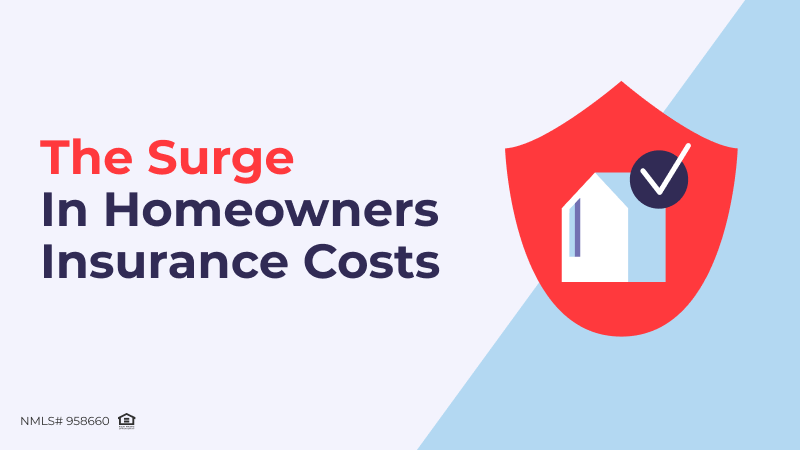In recent times, we’ve witnessed an unprecedented surge in insurance premiums, with average rates climbing nearly 19% in just the past year and an astonishing 55% increase since 2019. The implications of this surge extend far beyond the individual homeowner, influencing broader aspects of affordability, market accessibility, and the overall economic well-being of communities. Rising homeowners insurance costs can alter the calculus of home buying and ownership, impacting decisions and strategies at every level, from individual financial planning to industry-wide lending practices.
In this article, we will deal with the complexities of homeowners insurance in today’s market. We’ll examine the underlying causes of rising premiums, dissect their implications for various stakeholders, and consider actionable strategies for mitigating these increases. Whether you’re a homeowner, a prospective buyer, or a professional in the real estate or insurance industries, this exploration aims to provide insights and guidance to help you adapt and thrive.
Why Homeowners Insurance Costs Are Rising
Struggling with
a loan scenario?
Get a solution in 30 minutes! Fill out
the short form and get your personal offer
Submit a Scenario
The surge in homeowners insurance costs is a culmination of various interconnected factors that have compounded over recent years. Understanding these elements is crucial for homeowners, mortgage brokers, and industry stakeholders.
Climate Change and Natural Disasters
The increasing frequency and severity of extreme weather events are undeniable driving forces behind the rising insurance premiums. Climate change has intensified the occurrence of hurricanes, wildfires, floods, and other natural disasters, leading to a spike in insurance claims. States that are particularly prone to these events, such as California with its wildfires and Florida with its hurricanes, have seen dramatic increases in insurance costs. The industry’s response has been to raise premiums to cover the heightened risk, but this has also led to insurers withdrawing from high-risk markets altogether, further driving up prices due to reduced competition.
Technological Advancements in Risk Assessment
Insurers now employ sophisticated technology. For example, aerial imagery and data analytics help assess property risks more accurately. While this has led to more personalized insurance policies, it has also resulted in higher premiums for properties in areas identified as high-risk. This detailed risk assessment means that even homes in areas that were previously considered low-risk might now face higher premiums due to new data indicating potential vulnerabilities.
Reconstruction Costs and Material Prices
The rising costs of labor and building materials significantly impact homeowners insurance premiums. As the price for materials such as lumber, steel, and concrete increases, so does the cost to repair or rebuild homes after a loss. This inflation in reconstruction costs is directly passed on to the homeowner through increased premiums. Additionally, the global supply chain issues, exacerbated by the COVID-19 pandemic, have led to delays and further price increases, compounding the issue.
Legal and Litigation Costs
In certain regions, particularly those prone to lawsuits, insurance companies face high legal and litigation costs. States with litigious environments or where policies like “assignment of benefits” are prevalent see higher insurance costs due to the increased risk of fraud and excessive lawsuits. These legal expenses are factored into the overall cost of insurance, contributing to higher premiums for homeowners.
Regulatory Environment
State-specific insurance regulations and policies can significantly influence premium rates. Some states have stringent requirements that can drive up the cost of insurance. For example, mandates for comprehensive coverage or caps on rate increases can lead to insurers raising premiums across the board to maintain profitability. Conversely, states with less regulation may experience more market competition, which can help moderate premium increases.
Insurance Company Financial Health
The financial stability of insurance companies also plays a role. Companies must maintain a certain level of reserves to pay out claims, especially after widespread disasters. If insurers face significant losses or are unable to adequately reserve funds, they may need to increase premiums to ensure their financial health and ability to cover future claims.
The driving forces behind rising homeowners insurance premiums are complex and multifaceted. It’s a balance between managing risks, covering costs, and providing affordable coverage. Homeowners, brokers, and policymakers must work together to address these challenges, exploring innovative solutions and advocating for sustainable practices to ensure the long-term affordability and availability of homeowners insurance.
Implications for Homeowners and Mortgage Brokers
The sharp rise in homeowners insurance premiums has profound implications, not only for homeowners but also for mortgage brokers, who play a critical role in the homebuying process. It is of high importance for both parties to adapt and reconsider their strategies to ensure financial sustainability and housing affordability.
Implications for Homeowners
- Increased Financial Burden. For homeowners, the immediate impact of rising insurance costs is a heavier financial burden. Higher premiums mean higher monthly expenses, directly affecting households’ budgets and disposable income. This increase can lead some homeowners to compromise on coverage to lower costs, potentially leaving them underinsured and vulnerable in the event of a disaster.
- Homeownership Affordability. The affordability of homeownership is also significantly impacted. For prospective buyers, higher insurance rates increase the overall cost of owning a home, potentially pushing the dream of homeownership out of reach, especially for first-time buyers and those in high-risk areas. It may also influence the type of property they can afford or the location they choose to buy in.
- Impact on Home Equity and Investment. For existing homeowners, rising insurance costs could affect home equity and the long-term value of their investment. As insurance premiums increase, the total cost of ownership rises, which can affect resale values, especially in areas where high insurance costs are coupled with other market challenges.
Implications for Mortgage Brokers
- Changing Loan Affordability. Mortgage brokers must grapple with the fact that rising insurance premiums can significantly impact loan affordability. The increase in monthly homeownership costs affects debt-to-income ratios, a crucial factor in mortgage qualification. Brokers may find it more challenging to secure loan approvals for clients, particularly those on the brink of affordability.
- Altered Advising Strategies. Mortgage brokers need to adapt their advising strategies in light of these changing dynamics. This includes providing clients with comprehensive cost analyses that include potential future increases in insurance premiums and advising on the importance of shopping for competitive insurance rates. Brokers may also need to guide clients through the implications of choosing higher deductibles or different coverage options to manage costs.
- Risk Assessment and Education. With the rise in premiums largely driven by increased risks, especially in certain areas, mortgage brokers have a critical role in educating clients about these risks. This includes the potential for natural disasters, how they can impact insurance rates, and the importance of appropriate coverage. Brokers can position themselves as valuable resources by providing clients with information on how to mitigate risks and possibly lower their insurance costs.
- Navigating Regional Variations. Mortgage brokers operating in regions with significant disparities in insurance premium increases must be especially adept at navigating these variations. They need to stay informed about local and state-level insurance trends and regulations to provide relevant advice to clients in different areas.
- Long-term Client Planning. Finally, mortgage brokers must take a long-term view when assisting clients. This involves not only helping clients secure a mortgage but also planning for future homeownership costs. That, of course, includes potential increases in insurance premiums. Brokers can aid clients in understanding the total cost of owning a home over time and preparing financially for these expenses.
Homeowners Insurance Costs: Strategies for Mitigation
In response to the escalating costs of homeowners insurance, both homeowners and industry professionals, such as mortgage brokers, need to adopt various strategies to mitigate these increases and manage the impact on affordability. Here’s a deeper look into the approaches that can be adopted:
For Homeowners
- Enhance Home Resilience. One of the most effective strategies for homeowners is to invest in making their homes more resistant to natural disasters. This can include upgrading roofing materials to more durable options, installing storm shutters, reinforcing structures against earthquakes, and improving drainage systems to prevent flood damage. These improvements can not only reduce the risk of damage but also lead to substantial discounts on insurance premiums.
- Shop Around for Insurance. Homeowners should not accept their current insurance rates as the only option available. Shopping around and comparing quotes from multiple insurers can uncover more affordable rates with similar coverage. Independent agents can be particularly helpful as they can compare policies from various companies.
- Increase Deductibles. Opting for a higher deductible can lower premiums significantly. However, homeowners must ensure that they can afford to pay the higher deductible in the event of a claim. This strategy is best suited for those who have emergency savings or can set aside funds over time.
- Bundle Insurance Policies. Many insurance companies offer discounts to customers who bundle multiple policies, such as home and auto insurance. This can be an effective way to lower overall insurance costs while maintaining comprehensive coverage.
- Maintain a Good Credit Score. In many states, insurance companies use credit scores as one factor in determining premiums. Maintaining a good credit score can help homeowners qualify for lower rates.
- Seek Out Additional Discounts. Homeowners should ask their insurers about any additional discounts for which they may be eligible. These can include discounts for being a non-smoker, having a home security system, being an older citizen, or being claim-free for a certain number of years.
For Mortgage Brokers
- Educate Clients. Mortgage brokers should educate their clients about the impact of insurance costs on overall affordability and the strategies for mitigating these costs. Providing clients with resources and information on how to lower insurance premiums can add value and help build long-term client relationships.
- Incorporate Insurance Estimates Early. When advising clients, mortgage brokers should incorporate estimated insurance costs early in the home-buying process. This helps ensure that clients have a realistic understanding of total monthly payments and affordability.
- Leverage Technology. Utilize technology platforms that provide real-time insurance quotes and comparisons as part of the mortgage advising process. This can help clients make informed decisions and potentially find more affordable options.
- Advocate for Clients. Mortgage brokers can work with insurance agents and underwriters to explore all possible discounts and coverage options. They can also assist clients in understanding the benefits of investing in home improvements that reduce insurance costs.
- Monitor Market Changes. Stay informed about changes in the insurance market, including new products, services, and regulations that may benefit clients. By being proactive, mortgage brokers can provide timely advice that helps clients navigate the evolving landscape of homeowners insurance.
Homeowners and mortgage brokers can work together with these strategies to mitigate the impact of rising homeowners’ insurance costs. While some strategies may offer immediate relief, others are more long-term solutions that require planning and investment. The key is to adopt a proactive and informed approach to insurance, ensuring that coverage is not only affordable but also adequate to protect the home.
Looking Ahead at Homeowners Insurance Costs
When it comes to homeowners insurance market, understanding the trends and preparing for the future is essential. Looking ahead involves not just bracing for more of the same but also anticipating changes in the market, regulatory environments, and consumer behavior. Here’s a deeper dive into what the future may hold and how both homeowners and industry professionals can prepare:
Evolving Insurance Landscape
The insurance industry is undergoing significant transformations, driven by technological advancements, changing climate patterns, and evolving consumer expectations. Innovations such as AI and machine learning are reshaping risk assessment and pricing models. This potentially leads to more personalized and dynamic insurance products. Homeowners and mortgage brokers should stay informed about these developments, as they may offer new ways to manage costs and risks.
Regulatory Changes
State and federal regulations play a significant role in the insurance market. Legislative actions aimed at addressing the affordability and availability of insurance, especially in disaster-prone areas, could lead to significant shifts in premium rates and coverage options. Staying abreast of regulatory changes and understanding their implications will be crucial for making informed decisions and advising clients effectively.
Climate Adaptation and Resilience Building
With climate change being a significant driver of insurance cost increases, efforts to build more resilient communities will become increasingly important. This includes not only individual homeowners upgrading their properties but also broader community and governmental initiatives to improve infrastructure and reduce risk. Homeowners and industry professionals should engage with these efforts. They can lead to long-term benefits in terms of risk reduction and insurance affordability.
Consumer Education and Advocacy
As the market evolves, consumer education will become even more critical. Homeowners need to understand their insurance needs, the factors that influence their premiums, and the steps they can take to protect their homes and manage costs. Mortgage brokers and insurance agents play a key role, providing valuable advice and advocacy for their clients.
Long-term Financial Planning
Looking ahead, long-term financial planning becomes increasingly important for homeowners. This includes not just budgeting for current insurance costs but also preparing for potential future increases and unexpected events. Building an emergency fund, reviewing and updating insurance coverage regularly, and considering investments in home improvements are all strategies that contribute to financial resilience.
Market Competition and Innovation
The insurance market may see increased competition and innovation. This happens naturally with new players entering the field and existing companies seeking to differentiate themselves. This could lead to more options and potentially lower costs for consumers. Homeowners and mortgage brokers should keep an eye on market dynamics and be ready to explore new products and services.
Key Takeaways
Struggling with a loan scenario?
Get a solution in 30 minutes!
Fill out the short form and get a call from our AE
Submit a Scenario
For homeowners, the path forward involves more than just grappling with higher premiums. It’s about proactive engagement with their property’s safety, financial resilience, and active participation in the insurance process. This includes adopting mitigation strategies and staying informed about the market and regulatory changes that affect insurance policies and rates.
Mortgage brokers have a crucial advisory role that extends beyond the immediate concerns of home financing. They must obtain a comprehensive understanding of insurance to help their clients secure a home loan. Their role as educators and advocates has never been more vital.
Conclusion
In conclusion, the rise of homeowners insurance costs presents a multifaceted challenge that demands a multifaceted response. It’s a call to action for homeowners, industry professionals, and policymakers alike to engage with these issues thoughtfully and collaboratively. By doing so, we can work towards a future where the dream of homeownership remains accessible and protected against the unpredictable changes.




